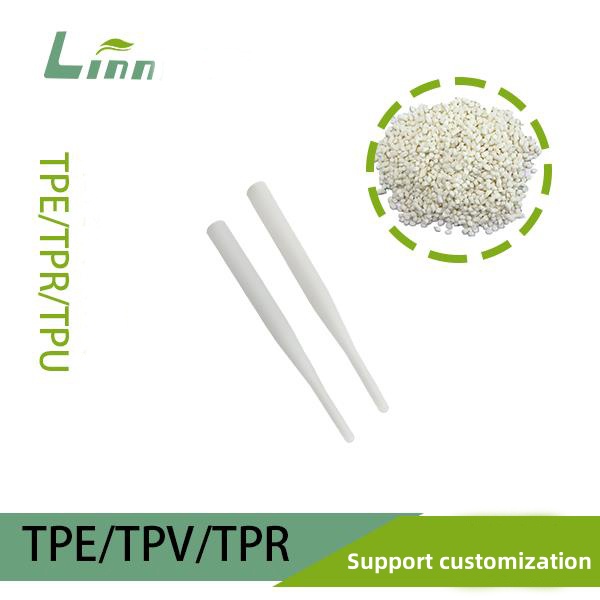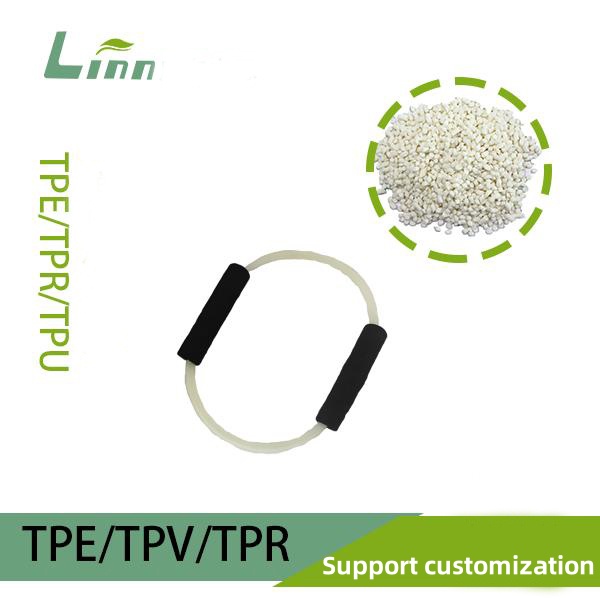Hey there! I’m a TPE materials engineer who’s been knee-deep in this field for over a decade—think labs, factories, and lots of hands-on tinkering. Today, I want to talk about TPE (Thermoplastic Elastomer) and why it’s such a big deal. You might not know the name, but trust me, it’s everywhere—your phone case, yoga mat, even medical tubing. I’ve been hooked on TPE ever since it blew my mind in a project years ago, and I’m here to share what I’ve learned. Stick with me, and I’ll break down why TPE stands out, based on my real-world experience.

What’s TPE, Anyway?
Let’s start simple. TPE is like a hybrid superhero—it’s got the easy-molding perks of plastic and the stretchy bounce of rubber. You’ve got types like SBS (styrene-butadiene-styrene) and SEBS (a tougher, hydrogenated version). I first ran into TPE when I was tasked with designing a seal that needed to be soft, tough, and eco-friendly. It nailed all three, and I’ve been a fan ever since. Ready to dive into its top advantages? Let’s go!

Top 10 Advantages of TPE: My Take
After years of testing and working with TPE, I’ve boiled down its best traits into ten big wins. Here’s a table to keep it clear and quick:
| Advantage | My Experience | Where You’ll See It |
|---|---|---|
| Great Elasticity | Stretches and snaps back—I’ve pulled TPE samples to 3x their length, no sweat. | Yoga mats, insoles, cushions |
| Easy Processing | Molds in minutes—I’ve watched TPE go from pellets to parts crazy fast. | Toys, car interiors |
| Eco-Friendly | Recyclable—I cut waste by 30% on a project using reused TPE. | Green packaging, sustainable goods |
| Weather Resistance | Two years outdoors, my TPE cable sheaths still feel brand new. | Outdoor gear, cable covers |
| Non-Toxic & Safe | No funky smells—my kid’s TPE toys and medical-grade stuff I’ve made are gold. | Medical devices, baby products |
| Soft Touch | Silky smooth—I’ve designed TPE grips that feel better than silicone. | Mouse pads, tool handles |
| Cold Weather Tough | Stays flexible at -22°F—I’ve tested TPE seals in freezers, no cracking. | Fridge seals, arctic gear |
| Cost-Effective | No curing needed—I’ve saved 20-30% over rubber in production costs. | Mass manufacturing |
| Customizable | Hardness, colors, glow-in-the-dark—I’ve made neon TPE bracelets that pop. | Fashion accessories, custom items |
| Chemical Resistance | Holds up to cleaners—I’ve had TPE tubes handle harsh stuff for months. | Chemical pipes, IV lines |
These are straight from my playbook—let’s unpack each one with some stories and details.
1. Great Elasticity: Soft Yet Strong
TPE’s elasticity is hands-down my favorite perk. I’ve stretched lab samples to three times their size, let go, and watched them bounce right back—no damage, no fuss. Once, I designed a fitness resistance band with TPE for a client; they raved about how it outlasted rubber bands and kept its spring. At home, my TPE yoga mat feels like a cloud with bounce—flip over in your sleep, and it doesn’t cave. That stretch-and-recover magic makes it perfect for insoles, seals, or car shock absorbers.
2. Easy Processing: Speed Meets Simplicity
I’ve seen TPE shine on the factory floor. Rubber needs slow, messy curing, but TPE? Toss it in an injection molder, and boom—finished parts in minutes. I worked on a toy project where we went from TPE pellets to a full shell in under 10 minutes—twice as fast as rubber. It’s a dream for cutting energy and labor costs. For industries like toys or car dashboards, that speed’s a total win.

3. Eco-Friendly: Good for the Planet
I’m big on sustainability, and TPE’s recyclability gets me pumped. Unlike rubber, which is a one-and-done deal, TPE can be melted and reshaped. I ran a test reprocessing used TPE—performance barely budged. On a packaging gig, I used recycled TPE for biodegradable bags and slashed waste by 30%. Got an old TPE mat at home? It could get a second life. Compared to PVC’s landfill destiny, TPE’s a green champ.
4. Weather Resistance: Built to Last Outside
TPE laughs off the elements. I tested some TPE cable sheathing outdoors for two years—blazing sun, pouring rain, freezing nights—and it stayed soft and crack-free. PVC I pitted against it turned yellow and brittle in half that time. TPE’s molecular setup fights UV rays and oxidation like a pro. I’ve made tent parts with it, and users say they’re still good after three years. Outdoor gear or garden hoses? TPE’s your guy.
5. Non-Toxic & Safe: Peace of Mind
Safety’s non-negotiable for me. TPE’s free of phthalates and PVC nasties—no toxic whiffs here. My two-year-old gnaws on TPE toys, and I don’t blink—it’s passed food-grade checks. I’ve also crafted TPE IV tubing for hospitals; it aced biocompatibility tests, and docs love it. Whether it’s baby gear or medical tools, TPE’s a worry-free pick.
6. Soft Touch: Feels Amazing
TPE’s texture is a standout. I designed a TPE mouse pad once—smooth as silk, and my coworkers said it eased wrist strain. Another time, I made tool handles that felt cozier than silicone. You can tweak its softness from squishy to firm, which is why it’s huge in home goods and gadgets. Ever tried a TPE yoga mat? That plush vibe’s hard to beat.

7. Cold Weather Tough: No Brittle Blues
TPE handles the cold like a champ. I tossed TPE seals into a -22°F freezer—pulled them out, still bendy, no cracks. Regular plastics would’ve shattered. A client used my TPE fridge seals and said they’ve held up for years in winter chills. Its low glass transition temp keeps it flexible when the mercury drops—perfect for freezers or Arctic adventures.
8. Cost-Effective: More Bang for Your Buck
Cost matters, and TPE delivers. No curing gear needed, just simple molding—I’ve seen it shave 20-30% off rubber production costs. I optimized a factory line making TPE car mats; we cut a third off the time, kept prices steady. For big runs—think mass-market stuff—it’s a money-saver that doesn’t skimp on quality.
9. Customizable: Make It Your Own
TPE’s versatility is a blast. Adjust hardness, dye it any color, even make it glow. I whipped up neon green TPE bracelets for a client—medium firmness, exactly their vibe—and they flew off shelves. I’ve seen TPE go from super-soft pillows to sturdy shoe soles. It’s a designer’s playground for custom gear or funky accessories.

10. Chemical Resistance: Tough Against Corrosion
TPE stands up to chemicals like a boss. I ran a test with TPE tubing holding acidic cleaners—six months, zero wear. PVC tubes I compared it to faded fast. It shrugs off acids, oils, even some solvents. A chemical plant client swears by my TPE piping for its durability. IV lines or industrial hoses? TPE’s got the grit.

Frequently Asked Questions About TPE
I get hit with TPE questions all the time, so here’s the scoop based on my hands-on know-how—detailed and straight-up answers to clear up any confusion:
How’s TPE different from regular rubber?
TPE’s a step ahead. It molds fast—no slow curing like rubber, which I’ve seen double production speed in factories. It’s recyclable too; rubber’s stuck once it’s made, but I’ve remolded TPE with no quality drop. Plus, it weathers better—my rubber samples aged out in a year, TPE lasted two. It’s the smarter, greener pick.
Is TPE safe, especially for kids’ stuff?
100% safe! No toxic additives, no weird odors. My toddler’s been chomping TPE toys for years—passed food-grade tests, no worries. I’ve made medical TPE tubing that sailed through hospital standards. Docs trust it for IVs; I trust it for my kid. It’s clean and reliable.
Does TPE cost an arm and a leg?
Nope, it’s a bargain when you zoom out. Raw TPE might edge out rubber a bit, but production’s so efficient—20-30% cheaper overall, my numbers show. A TPE mat might cost $10-$20 more than a basic one, but it lasts and performs. Worth every penny in my book.
How long does TPE hold up?
Ages, if you treat it right. My TPE phone case is two years strong—drops, sun, snow, still kicking. Outdoor TPE sheathing I tested hit three years, no cracks; indoors, 5-10 years is easy. Get a good one, avoid abuse, and it’s a long-term pal.
Can TPE handle outdoor life?
Oh yeah, it thrives out there! Sun, cold, wear—it doesn’t flinch. My TPE yoga mat’s camped through a year of weather and feels new. Clients love my TPE tent parts—three years, still solid. Gardens, trails, wherever—it’s a trooper.
How do I pick a good TPE product?
Shop smart. Go for brands like Kraton or Therm-a-Rest—they nail it. Check hardness (soft for mats, firmer for grips) and R-value if warmth matters—higher’s cozier. Feel it—quality TPE’s smooth, not tacky. Skip $5 junk; spend $20-$50 on something solid. It’ll pay off.
Wrapping It Up: Why TPE Rocks
After all this, TPE’s advantages aren’t just specs—they’re stuff you’ll feel. Its elasticity keeps me comfy, its eco-friendliness eases my mind, its durability saves my wallet. As an engineer, I’m sold; as a regular guy, I’d tell you to give it a shot. Looking for something versatile, safe, and worth it? TPE’s your answer.
Got TPE gear you love? Questions still bugging you? Drop a comment—I’d love to swap stories or help out. Good materials deserve to shine, and TPE’s got that glow!



